Learn about some Battery technologies
The battery is a hardware component that provides power to a device, allowing it to operate without a power cord. Batteries are often able to power laptops for several hours depending on the amount of energy needed. Today, high-end devices like laptops and smartphones use rechargeable batteries, allowing users to charge batteries when they run out of energy.
Learn about some Battery technologies
- Computer battery
- Battery technology
- Lithium ion batteries
- Lithium polymer battery (Lithium polymer cell)
- Nickel cadmium batteries (NiCd or NiCad)
- Nickel metal hydride battery (NiMH)
Computer battery
There are three types of batteries used for computers. The first is a backup battery, often called a CMOS battery, that contains computer settings such as time and date. If you don't have a CMOS battery, you'll have to reset the time, date and other system settings every time you start your computer. Next, the Bridge battery is only found in laptops as a temporary backup for the main battery. This battery allows you to remove the main battery and replace the battery without turning off the computer. Finally the main battery in the laptop, this is the power supply to the computer when it is not connected to a wall outlet.
The image below is an example of a laptop battery shape when removed from a computer.

Battery technology
There are many different battery technologies, here are some main types.
Lithium ion batteries
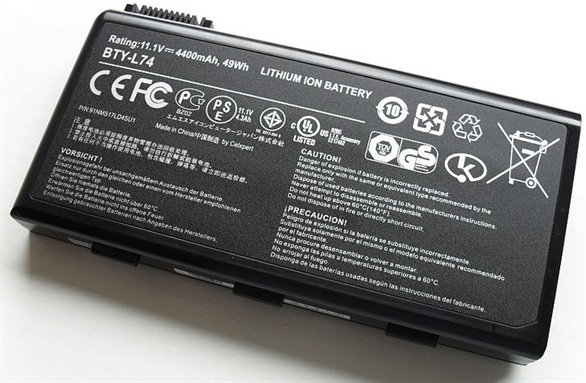
Lithium ion batteries, short for Li-ion, are a technology that requires a protection circuit. It is used when high energy density is needed. Li-ion batteries are more expensive than other batteries, but they do not cause memory problems.
Lithium batteries have been built by GN Lewis since 1912 but it wasn't until the early 1970s that the first non-rechargeable Lithium batteries became popular. Efforts to develop Lithium batteries continue to be carried out in the 1980s but failed due to safety concerns.
Lithium is the lightest of all metals, has the largest electrochemical performance and provides high energy levels. Rechargeable batteries use lithium metal as an electrode capable of providing high voltage and excellent capacity, creating a high energy density.
After much research in the 1980s, it was discovered that the branch structure of lithium in short form can cause thermal run-away. When the temperature of the battery is close to the melting point of lithium, resulting in backlash. A large amount of rechargeable Lithium batteries sent to Japan were sent back in 1991 after the cell phone battery exploded and burned a man's face.
- "Dissecting" Lithium batteries to find out the cause of the fire due to backup charging?
With the inherent instability of lithium metal, especially during charging, studies turned to non-metallic lithium batteries using lithium ions from chemicals such as Lithium-Cobalt Dioxide (LiCoO2). Although the energy density is slightly lower than that of lithium metal, but Li-ion is safe, providing certain precautions to meet when charging and discharging electricity. In 1991, Sony commercialized Li-ion and is now the largest supplier of this battery.
Advantages of Lithium ion
Although there are fire risks (this risk is not much), these batteries are very widely used in electronic devices, especially laptops. The reason for this is that there are many advantages in using Lithium ion batteries. One advantage is that Lithium has a small atomic mass, so the weight of the battery is small. Combined with the fact that lithium has a very strong reaction, it can produce a tremendous amount of energy in its chemical reactions. These two coefficients are the two factors we need to choose lithium. Many laptop and PDA factories like to use this battery in their products because it is smaller, lighter and more beautiful.
When not in use, these batteries retain electrical charge very well, losing only about 5% of the electrical energy per month. Besides, it has no effect on the memory associated with this technology. That means you don't have to discharge the battery before recharging. Not only are you not, but you can recharge it up to hundreds of times before you can no longer use it.
Disadvantages of Lithium ion
Many advantages like this but this type of battery also has some disadvantages, partly from small risks in leading to fire. One of its main drawbacks is the life expectancy of 2-3 years, whether you use it or not. So if the battery in your laptop is still stored in the warehouse for about a year before you attach it to your laptop, you will still enjoy a negligible life. So when you buy a device, you need to check the time on the battery was produced from the date of year.
Lithium ion batteries also need complex integrated circuits to manage its performance. This circuit will increase the cost of the battery compared to other technologies. So why do they need these circuits? One of the reasons is to make sure that the battery does not have to discharge every time it is recharged. If a battery of this type is discharged, it will be useless. When the battery is low, the board will stop battery operation to prevent discharge.
Lithium polymer battery (Lithium polymer cell)
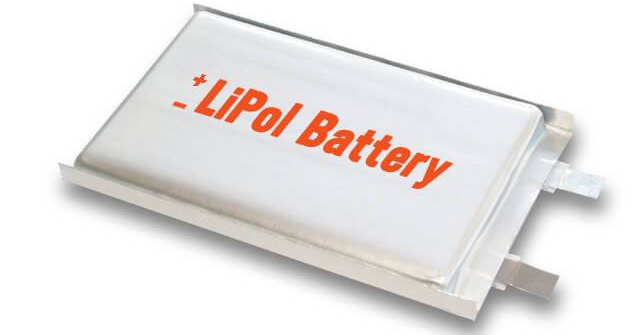
An alternative to Lithium ion batteries is Lithium polymer cell. This technology is almost identical to Lithium ion technology. The main difference between them is that instead of a battery having a liquid it is a hard substance. We will take into consideration some advantages and disadvantages of this battery.
Advantages of Lithium polymer
One advantage of these new batteries is that they can withstand physical collisions. Another idea is that production costs are also lower.
Another advantage is that it can be shaped to fit different devices. This problem is possible because it does not need a rigid external enclosure. In Lithium ion batteries, external hard covers are required to hold the plates. For Lithium polymer batteries, the separator and the extruded plates are laminated together, except for the need for metal casing. Without this metal casing, Lithium polymer batteries are also much lighter than Lithium ion. And another important issue is that lithium polymer cells are better able to withstand physical collisions, thus reducing the risk of losing protection of the metal casing.
Below is a battery made by NASA, which uses lithium polymer technology. We can imagine some unique applications, places where NASA will need advantages in weight and shape advantages allowed by this lithium polymer technology.
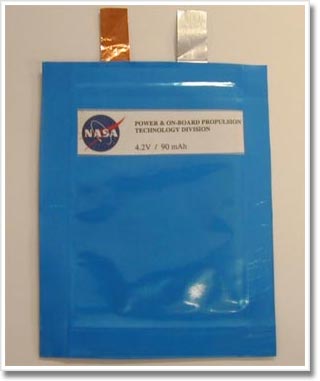
When compared to Lithium ion, Lithium polymer batteries also allow for more charge and discharge. Typically, you can perform charging up to more than 500 times before its capacity drops to 80%.
With all these advantages, Lithium polymer batteries are rapidly gaining popularity in mobile electronic devices such as PDAs, handsets and iPod devices. You can also find in some laptops that have this technology like Apple MacBook Pro computers.
Nickel cadmium batteries (NiCd or NiCad)
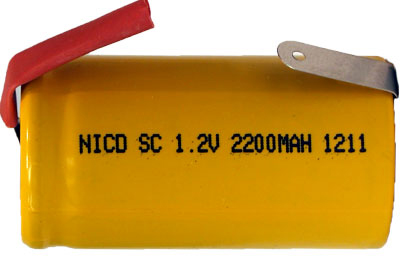
Nickel cadmium batteries (NiCd or NiCad) are rechargeable batteries used for laptops, drills, camcorders and other small battery-operated devices. NiCd batteries use electrodes made of nickel oxide hydroxide, metal cadmium and an alkaline electrolyte of potassium hydroxide. The NiCd battery was released by Waldemar Junger and was patented in 1899.
Two or more NiCd batteries combine to form a battery. Because they are usually the same size as the main battery (non-rechargeable batteries), NiCd batteries have lower extreme voltages and fewer ampere hours. However, NiCd batteries provide continuous polarity almost during charging, unlike the main battery, which leads to almost undetectable intermittent charging. During discharge, the NiCd battery turns chemical energy into electrical energy. During recharging, NiCd batteries transmit electrical energy back into chemical energy.
Advantages of NiCd batteries:
- Deep discharge of electricity for a long time.
- More charging / discharging rings than other rechargeable batteries, so the battery life is longer.
- The energy density is higher, lighter and more compact than the lead acid battery. NiCd is suitable for devices that focus on size and weight.
- The self-discharge speed is lower than that of nickel metal hydride batteries (NiMH) (20% / month compared to 30% / month).
NiCd batteries are extremely toxic. In addition, nickel and cadmium are expensive metals. Unlike lead acid batteries, NiCd batteries are extremely hot, in the heat exit mode and self-destruct if charged by a dynamo, even in a self-disconnecting system. However, NiCd batteries are often equipped with an internal thermal charger, which signals if the battery is hot and reaches the maximum voltage.
Nickel metal hydride battery (NiMH)
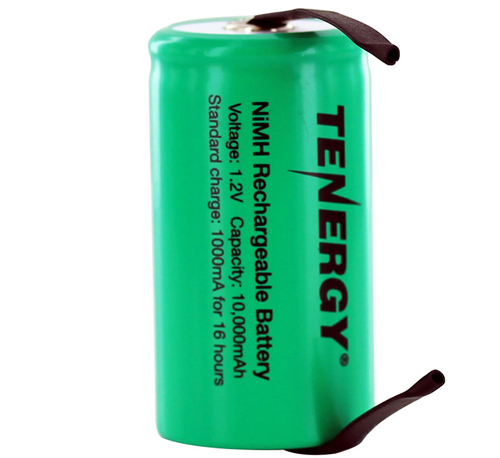
Nickel metal hydride batteries (NiMH) have been widely used in recent years as a type of rechargeable battery. NiMH cells provide the same characteristics as the older NiCard technology, but with the advantage that NiMH batteries do not have an adverse environmental impact, they can also provide higher energy density and capacity. Overall charging increased. Therefore, NiMH batteries are now widely used, providing high performance.
NiMH batteries have a number of outstanding features that make them widely used, and of course there are drawbacks.
- Environmental impact : NiMH battery technology has overcome the "brother" NiCd because of its lower environmental impact. Although NiMH batteries do not use toxic cadmium, the extraction and processing of other metals creates some environmental threats, but when NiMH batteries expire, most nickel can be recovered easily.
- Energy density : NiMH batteries have a higher specific energy level, ie the amount of energy that can be contained in a certain volume. It can range from 60-100 Wh / kg compared to 40-60 for NiCd.
- Output voltage: It provides the same voltage of 1.2 volts as NiCd, making them interchangeable.
- Self-discharge: a disadvantage of NiMH batteries is its high self-discharge. It can take up to 3% of power in a storage week.
See more:
- Fix "plugged in, not charging" laptop battery error
- How do I know if my laptop battery is bottled or broken?
- How to recover and improve performance for battery-powered laptop batteries
You should read it
- Scientists have successfully developed a lithium battery that will never explode despite overheating
- New technology helps prevent smartphone batteries from catching and exploding
- Battery thin-film - A safe alternative to lithium-ion batteries
- 'Dissecting' Lithium batteries to find out the cause of the fire due to backup charging?
- What is solid battery? Will they solve the battery life problem?
- Don't, and exactly, never leave your phone down to 0% battery!
- India successfully develops the world's first iron-ion battery, will lithium-ion batteries be replaced in the future?
- Causes and ways to detect iPhone batteries are about to explode
- What is Protect Battery on Samsung phones? Should I use it?
- Future smartphone battery technologies
- Slow charging does not help extend battery life
- Experience choosing the best battery drill






 Future smartphone battery technologies
Future smartphone battery technologies Learn energy saving technologies on OS X Mavericks
Learn energy saving technologies on OS X Mavericks US company announces breakthrough battery technology with unprecedented power
US company announces breakthrough battery technology with unprecedented power 4G and 5G, which technology consumes more battery?
4G and 5G, which technology consumes more battery? Learn about RAM technologies: DRAM, SRAM, SDRAM and newer
Learn about RAM technologies: DRAM, SRAM, SDRAM and newer Top 5 tips for fast and safe phone battery charging
Top 5 tips for fast and safe phone battery charging